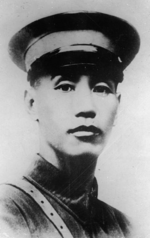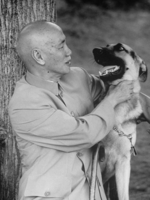Katurou Imahara
Prime Minister of Senria Katurou Imahara 이마하라까뚜로우 | |
|---|---|
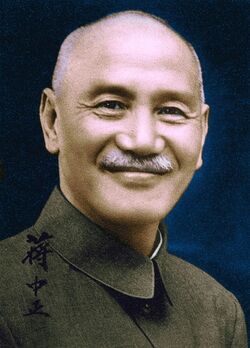 | |
| In office December 11, 1933 – December 14, 1953 | |
| Deputy | Iturou Nakagawa Hatirou Nakayama |
| Preceded by | Position created Himself (as Chairman) |
| Succeeded by | Hatirou Nakayama |
| In office July 10, 1927 – December 11, 1933 | |
| Preceded by | Position created Isao Isiyama (as Speaker) |
| Succeeded by | Position abolished Himself (as Prime Minister) |
| In office December 12, 1923 – July 10, 1927 | |
| President | Isao Isiyama |
| Preceded by | Position created |
| Succeeded by | Position abolished Himself (as Chairman) |
| Personal details | |
| Born | September 30, 1883 |
| Died | April 5, 1954 (70 years) |
| Nationality | Senrian |
| Political party | |
| Spouse | Keiko Minamoto |
| Children | Kitirou Imahara (adopted) |
| Alma mater | Tokiyori Imperial Military Academy |
| Profession | Soldier, general, politician |
| Signature | |
| Military service | |
| Allegiance | |
| Branch/service | |
| Rank | Grand marshal |
| Battles/wars | First Sakata Incident 1909 Concession Riots Senrian Revolution Second Sakata Incident Great War Solarian War |
| ||
|---|---|---|
|
||
Katurou Imahara (Senrian: 이마하라까뚜로우, Imahara Katurou; Gyoumon: 今原勝郎; September 30, 1883 - April 5, 1954) was a Senrian military and political leader who served as the leader of Senria, first as head of the Government of National Preservation and then as Prime Minister, between 1927 and 1948. He played an important role in both the Senrian Revolution and the Great War, and in the subsequent reconstruction of the country into a military and economic power, undertaking a sweeping set of reforms in line with is personal ideology; as a result, he is widely known as the "Father of the Fatherland" within Senria.
Born into a sizoku family in Nisiyama, Imahara was groomed for a life in the military; he graduated from Tokiyori Imperial Military Academy and became an officer in the Imperial Senrian Army in 1901, ascending to the rank of general by 1919. Initially a distinguished figure on the imperial side during the Senrian Revolution, he became frustrated with the imperial government and subsequently became a leading figure in the Gang of Six, the group of generals that overthrew the Emperor Katuhito in 1923. He subsequently formed a power-sharing agreement between the Gang of Six and the revolutionary government of Isao Isiyama, forming the Aikokutou to compete with Isiyama's Kyouwakai politically.
The ensuing government, headed by the Council of the Senrian State, was frequently paralyzed by conflict between Imahara and Isiyama. In 1926, with Isiyama's backing, Imahara provoked the Second Sakata Incident as a means of restoring public confidence in the struggling government. The Second Sakata Incident subsequently escalated into the Great War in 1927; with the divided government struggling to respond to a Xiaodongese invasion, the Council of the Senrian State voted to give Imahara unlimited power as the chairman of a "Government of National Preservation" for the duration of the conflict. As chairman, Imahara embarked on a campaign of total war, mobilizing all sectors of society towards the industrialization of the country and the modernization of the Senrian Republican Armed Forces. As the leader of a major Allied power, Imahara was involved heavily in the alliance's decision-making. Under his command, the Senrian military was able to slow and subsequently reverse the Xiaodongese advance, eventually launching an invasion of Xiaodong in 1933 and obtaining Xiaodong's surrender in 1935 after eight years of conflict.
Following the expulsion of Xiaodongese forces from Senria in 1932, Imahara oversaw the drafting of a new constitution, and was elected Prime Minister of Senria the following year. As Prime Minister, Imahara established a dominant-party state under the leadership of the Aikokutou, with public dissent strictly controlled and opposition groups subject to surveillance and periodic harassment. He also undertook a rigorous program of political and economic reforms aimed at continuing the country's industrialization, further modernizing the country's military, updating the country's legal and penal systems, and expanding infrastructure and public services, with the end goal of establishing a modern nation-state and bringing Senrian living standards on par with those in Euclea. He expanded social rights for women and burakumin, but simultaneously promoted "traditional morals" through initiatives such as the Public Virtue Movement. Imahara also worked tirelessly to promote Senrian culture and Senrian nationalism; his government heavily promoted museums and the arts, oversaw the shift from Gyoumon characters to the Kokumon script, and pursued a policy of Senrianization for ethnic minorities. Imahara further successfully sought the end of the various concessions and privileges imposed on Senria in previous decades by Euclean powers. He was reelected in 1938, 1943, and 1948; with his health declining, however, he opted to step down in 1953, handing power to Hatirou Nakayama. Imahara died of renal failure in 1954.
Imahara's political legacy is substantial and controversial. He is widely admired and memorialized in Senria, where he is credited with leading Senria to victory during the Great War and transforming the country into a modern economic and military power, and where his ideology, Imaharism, remains influential into the present. Imahara's military leadership played a critical role in both the Senrian Revolution and the Great War, and he is widely regarded as one of Kylaris's most talented military commander as a result. His supporters also credit him with vastly improving the Senrian standard of living, implementing women's suffrage, and promoting culture and the arts. Detractors and critics of Imahara's rule, however, denounce him as a military dictator who aggressively suppressed opposition in the name of preserving social order, violated the rights of ethnic minorities, established the monopolistic keiretu system, and created a culture of endemic corruption and illiberalism in Senrian governance.
Early life and education
Imahara was born on September 30, 1883 in the town of Marugame to Munetaka and Satiko Imahara. He was the fourth of seven children; he had one older sister, three younger sisters, and two older brothers. Both elder brothers were stillborn, however, and Imahara was treated as his parents' eldest, and only, son as a result. His parents had initially planned to give their sons generation names, as was typical among upper-class Senrians of the time, but following the stillbirths of his first two sons, his father opted to give Imahara the name Katurou (勝郎), literally meaning "victorious son", instead.
Satiko died of tuberculosis when Imahara was five, and as a result he was primarily raised by his father. The Imahara family belonged to the sizoku caste; his ancestors had been landed samurai for several generations and his father was a general in the Imperial Senrian Army who had played an important role in the Keiou Restoration, and as a result it was expected that Imahara would enter the military as well. Munetaka Imahara groomed his son for a military career from birth, as Imahara later recounted:
In my early childhood I was somewhat bookish, particularly inclined towards the classics of Senrian literature and poetry. My father did not oppose these interests - a proper warrior was supposed to be properly versed in these classics - but he did press me to place my primary focus upon those subjects which would more directly prepare me for a military career. So he instructed me to read military histories, works on strategy and tactics, and the biographies of famous commanders from Senria and elsewhere, and had me trained in both traditional and modern martial arts. Initially I had some hesitation, but he guided me firmly, and ultimately I took enthusiastically to these areas as well.
Imahara enrolled as a cadet at Tokiyori National Military Academy in 1901; he excelled in his classes and was popular both with his fellow students and with faculty. He graduated in 1905 as first in his class, immediately thereafter becoming an officer in the Imperial Senrian Army.
Before the Senrian Revolution
Imahara was initially assigned to an army garrison in the city of Tosei. There, he met Keiko Minamoto; Minamoto belonged to a hatamoto family from the region and, like Imahara, belonged to the sizoku caste. Imahara and Minamoto quickly developed a romantic relationship, and, in 1906, the pair resolved to marry. Both had previously been slated for arranged marriages; however, Imahara's betrothed died in 1904 of pneumonia before the marriage could go ahead, and Minamoto's father had broken her betrothal following a personal falling-out with her betrothed's father. Minamoto's father assented to the marriage, but Munetaka Imahara did not approve until after a meeting with Minamoto and her parents in 1907. The pair were married in June of that year.
Imahara's parentage, academic record, competence, tendency to ingratiate himself to superiors, and ambition helped him rise quickly through the officer corps. He was reassigned to command a coastal fortification in Aoyama in 1908, leaving Keiko in Tosei. While there, Imahara played a minor role in the First Sakata Incident, overseeing the garrison's response to the incursion of Xiaodongese ships into the Nangyoku Inland Sea and attempting to keep the city's port open during the ensuing Xiaodongese blockade. The First Sakata Incident resulted in the cession of Sakata to Xiaodong; anger regarding this decision exploded into the 1909 Concession Riots across much of Senria, but riots in Aoyama were averted after Imahara, riding at the head of a column of armed soldiers, spoke to demonstrators and convinced them to disperse.
As a result of his actions during the First Sakata Incident and the Concession Riots, Imahara was further promoted and reassigned to command a military garrison in Keisi, the country's capital; this time, Keiko came with him, and the two purchased a home in the northern areas of the city. During his time in Keisi, Imahara continued to rise through the ranks, reaching the rank of colonel in 1916.
During the Senrian Revolution
[as the commander of one of the garrisons in keisi, imahara possibly played some role in the massacre which provoked the senrev, though this is a charged topic then and now; the senrev begins as republicans led by Ryuunosuke Miyamoto and his Kyouwakai flee to Ukyou and declare a rival government ]
[as the revolution breaks out, Dragon King hisahito promotes imahara - all of thirty-five - to general and orders him to the front, where he proves a very competent commander]
[in 1919, hisahito is assassinated while travelling between the palace and tokiyori; his successor, katuhito, is left deeply paranoid by this and, as imahara was previously a garrison commander in keisi, reassigns him to command all garrisons in keisi; this frustrates imahara who wants to remain on the front, but he complies. he also orders a stupidly large number of soldiers and supplies expended upon fortifying keisi, over imahara's protests]
Gang of Six and the Reaping
[imahara is angry that he has to sit around keisi while the war is being fought elsewhere, and that both his protests and requests for reassignment are being ignored or rejected; he begins to reach out to other generals who are frustrated with katuhito rerouting supplies, countermanding orders, and generally mucking up the war effort; gradually a conspiracy begins to emerge to sideline or, potentially, dethrone the emperor]
[imahara and his close friend Iturou Nakagawa, an admiral based in keisi, form the initial core; they gain the explicit participation of generals Sintarou Miyake, Nobuyuki Youiti, and Isoroku Nomura and admiral Ienobu Miyazawa, who become the Gang of Six and the tacit consent of several others in the officers corps; loyalist general Noriyosi Horitome attempts to alert katuhito that he thinks there's funny business but katuhito dismisses it, in part because imahara's father was part of the keiou restoration]
[the 1923 Great Kinkeidou Earthquake destroys what little public support the monarchy still has; imahara and his wife, who have been unable to concieve, adopt an orphan named Kitirou Maeno; at the same time, imahara and the gang of six agree that clearly the monarchy is screwed and their best bet is to launch the plot, seize the capital and the emperor, and negotiate with the republicans of Isao Isiyama]
[the plan is carried out on November 27, 1923, The Reaping; it goes off basically without a hitch and imahara's forces capture keisi and the emperor]
[as a result of having keisi and katuhito, imahara becomes de facto leader of the gang, and isiyama opts to negotiate with him; a compromise between the two men is reached, and the senrev ends]
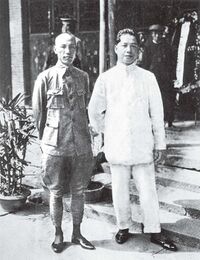
Before the Great War
[the structure of the council of state functionally paralyzes it; the republican loyalists who isiyama has brought to the table are hesitant to work with the ex-imperials of imahara, and the feeling is mutual, so to some extent there's two parallel governments that don't much want to work together]
[the biggest issue is reconstruction; both sides agree in principle here, but disputes over who oversees reconstruction and the associated funds delay things severely; keisi, notably, just kinda remains a ruin after the earthquake, and this becomes a symbol of gov't dysfunction]
[the second-biggest issue is economics, since senria was not off well economically even before the war; isiyama is rather left-wing and wants tight regulation and welfare, but imahara and his ilk are more hesitant or outright opposed, and this too gets bogged down]
Second Sakata Incident
[the paralysis on the council of the senrian state is becoming an issue and the gov't is getting worried that it will lose legitimacy; imahara writes to keiko that some decisive action will have to be retaken to restore public faith]
In July of 1926, intelligence forces loyal to Isao Isiyama obtained a Xiaodongese military report which stated that there was only a skeletal Xiaodongese military presence in Sakata because the Xiaodongese government did not regard the young, fragile Senrian republic as a military threat; instead, the city's defense was largely left to the municipal police force, which consisted mostly of ethnic Senrians. Isiyama relayed this information to the other members of the Council, including Imahara. Imahara proposed that Senria launch an operation to reclaim the city as a means to restore popular support for the Council of Senrian State, and requested that he command the operation; Isiyama agreed, on the condition that a member of the Kyouwakai would be the one to publicly announce the operation if it succeeded, a demand to which Imahara assented.
[the plan goes off, seemingly without a hitch]
[but then shit spirals out of control and the gw begins]
During the Great War

1927-1929
[the brief period before imahara becomes head of the gov't of national preservation, where senria looks entirely fucked; the failed otuzi-mareimeisa coup attempt, foiled by men under imahara's command]
[the situation gets desperate when xiaos land in kunigami; imahara is given dictatorship; "three-point plan" of "mass production, mass industrialization, and mass mobilization" unveiled]
[as dictator, imahara splits his time between keisi and commanding troops along the front, the latter being something he takes to naturally and also a way to compensate for being stuck in keisi during the revolution; this frustrates bureaucrats, and isiyama, but the senrian people like the image of imahara as an active leader]
[imahara works to sort out the military and integrate imaharists and isiyamists, though he *does* favor the former where he can; the loss of territory slows, and by 1929 things have slowed to a stalemate, but the situation is still dire]
[imahara is impressed by the work of organic resistance groups and decides the senrian gov't will encourage this; also, during the first major senrian offensive of the war, troops under imahara stumble on an extermination zone near kunigami, the first hard evidence senria has of the Senrian Genocide]
1930-1932
[senria's offensive stagnates and xiaodong attempts another, but between senria getting its shit together and the resistance strengthening, it's less effective; on the home front, the three-point plan continues apace thanks to financial and technical support from the euclean allies, with imahara giving control of many of these new factories and whatnot to a handful of close friends and political allies]
[the ukyou uprising; imahara works to smuggle arms and rations to the insurgents, but does not order an army offensive. this is one of his most controversial decisions and dogs him for years; he claims it was because senrian armies needed to recover and prepare for an offensive, but his opponents see a massive missed opportunity, or even a deliberate attempt to prevent the resistance developing an independent base of power]
[in '32, senria seizes control of the seas and launches a massive offensive on land; xiao morale is collapsing, between a blockade and resistance they have no supplies, and senria very rapidly retakes ground, liberating the entirety of the country by june]
[a bunch of collaborators and xiao generals end up trapped in senria and, spurred on by the genocidal horrors uncovered during the offensive, imahara orders them hunted down aggressively; most high-ranking individuals are executed, with lower-ranking individuals stringently punished or, in some cases, left for lynch mobs]
1933-1935
[senria invades jindao and xiaodong; imahara now largely remains in keisi, though he makes a few trips to the front in xiaodong; senria shows no mercy]
[initially things go well, but things get complicated; over time senria becomes overstretched and xiao resistance becomes an issue. also, a rift very clearly forms between imahara and euclean leaders, as imahara agitates for an end to euclean imperialism while euclea reacts poorly to things like the Nakagawa Plan]
[imahara finds himself in a bind as the front stagnates and it becomes clear that senria, for both practical reasons and because euclea won't allow it, won't get all it wants; eventually euclea forces imahara to make peace with xiaodong, the Treaty of Keisi]
As Prime Minister

[imahara and isiyama and co, once senria is driven out of xiaodong, negotiate the drafting of a new constitution and then of elections, which imahara and the Aikokutou win]
First term
[what imahara does as PM domestically during the final years of the great war]
Second term
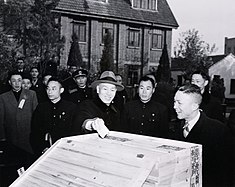
Third term
Fourth term
Later life
[retires to saeki, lives with keiko and several dogs; is too sick to be further involved in senrian politics]
Death
[death of renal failure; immediate responses from domestic and int'l figures; mourning across senria, his funeral, his burial]
Personal life

[imahara's relation with his parents and siblings; any living relatives through this line]
[imahara's relationship with his wife; her influence upon his ideology and governance]

[imahara's relationship with kitirou; kitirou's own rise to power on his father's legacy, and its end; any living heirs through this line]
[religion, hobbies, any other details i guess]
Legacy

[lauded in senria; elaborate further]
Criticism
Honors
Senrian honors
- Knight Grand Cross of the Supreme Order of the Jade Dragon
- Grand Cross of the Order of the Crimson Phoenix
- Grand Cross of the Order of the Plum Blossom
- Honor Saber of the Rearing Stag with Golden Tassel
- Grand Cross of the Order of the Diligent Ox
- Grand Cross of the Order of the Tricolor Banner
- Order of the Senrian Revolution, First Class
- Order of the War of Patriotic Resistance, First Class
- Order of the Striking Crane, First Class
- Order of the Roaring Tiger, First Class
- Order of the Empress Genmei, First Class
- Order of Service to the Senrian Nation, First Class

